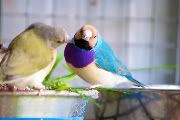Hi All
I have a pair of Zebs that appear to have a habit of producing deformed young. Their first clutch of this season consisted of 5 eggs, only one of which hatched. When the chick fledged I noticed it had a what appeared to be a bent spine. It seems to function normally and is doing fine (recently weaned), but it is quite obvious when it is sitting that something's amiss. Over the last few days their second clutch fledged. Two young, although I don't know how many eggs were laid as they nested in brush this time. One of the young appears healthy and normal. However I noticed today that the second chick is missing most of it's top beak (I will try and get a photo in the coming days). I'm not sure what would cause either of these issues. I did think calcium deficiency, but they get all the usual grit/cuttlefish, plus the other birds in the aviary are producing quality young. Is there something else going on with this pair or are these two issues just coincidence? I am considering splitting them up before they produce any more (obviously once the current fledlings are independant). Also, is this latest chick likely to be able to feed itself (assuming the beak doesn't come good)? All replies appreciated.
Cheers, Dal
Repeated deformities
- mackstaa
- ...............................

- Posts: 369
- Joined: 07 Mar 2011, 22:10
- Location: Boy from Basso
Hi Dal,
I would most definately split the pairs up with other partners, could be a number of reasons why your young are appearing this way, changing the genes the young are receiving would be a great start in life for them, Hard to say about the little fella with a deformed beak without a pic, but I would let it grow to see what happens, you dont have many choices there. Keep supplying the parents with the right food and housing and your doing the right thing, just split the parents so if you notice a deformity with your new pairing at least you know who might be the likely culprit.
I would most definately split the pairs up with other partners, could be a number of reasons why your young are appearing this way, changing the genes the young are receiving would be a great start in life for them, Hard to say about the little fella with a deformed beak without a pic, but I would let it grow to see what happens, you dont have many choices there. Keep supplying the parents with the right food and housing and your doing the right thing, just split the parents so if you notice a deformity with your new pairing at least you know who might be the likely culprit.
Mackstaa
- Dal
- ...............................

- Posts: 70
- Joined: 16 Jul 2012, 18:45
- Location: Lithgow NSW
Thanks for the advice Mackstaa. Will do.
Cheers
Misso, it was another thought I had. I can't say they AREN'T for certain. They were bought from the same breeder, so who knows???Misso wrote:parents related?
Cheers
- finchbreeder
- ^^^^^^^^^^^^^^

- Posts: 11647
- Joined: 27 Jun 2009, 20:00
- Location: Midwest of West. Aust. Coast
- Location: Midwest of West.Aust.Coast
Most likely in my oppinion, they are too closely related. Many people put a couple of Zebs in an avairy, then when they reach the dozens. Trap and sell half to 3/4. Fine if these birds are then used to unrelated. Zebs seem to have very little genetic problems. But nothing is imune to getting "the wrong" genes. And this form of breeding will bring out any problem that is going to occur. I breed my Zebs to cousins regularly. But I also regularly buy birds in for outcrossing. Contolled inbreeding and outcrossing is the most successful way to get what you want out of any thing you breed. Birds, cats, dogs, horses, cattle, sheep. The best are all bred this way. Appart of course from the random "star" that is bred from a first breeding of unrelated birds or whatever. But how often is anyone that lucky?
LML
LML
LML



